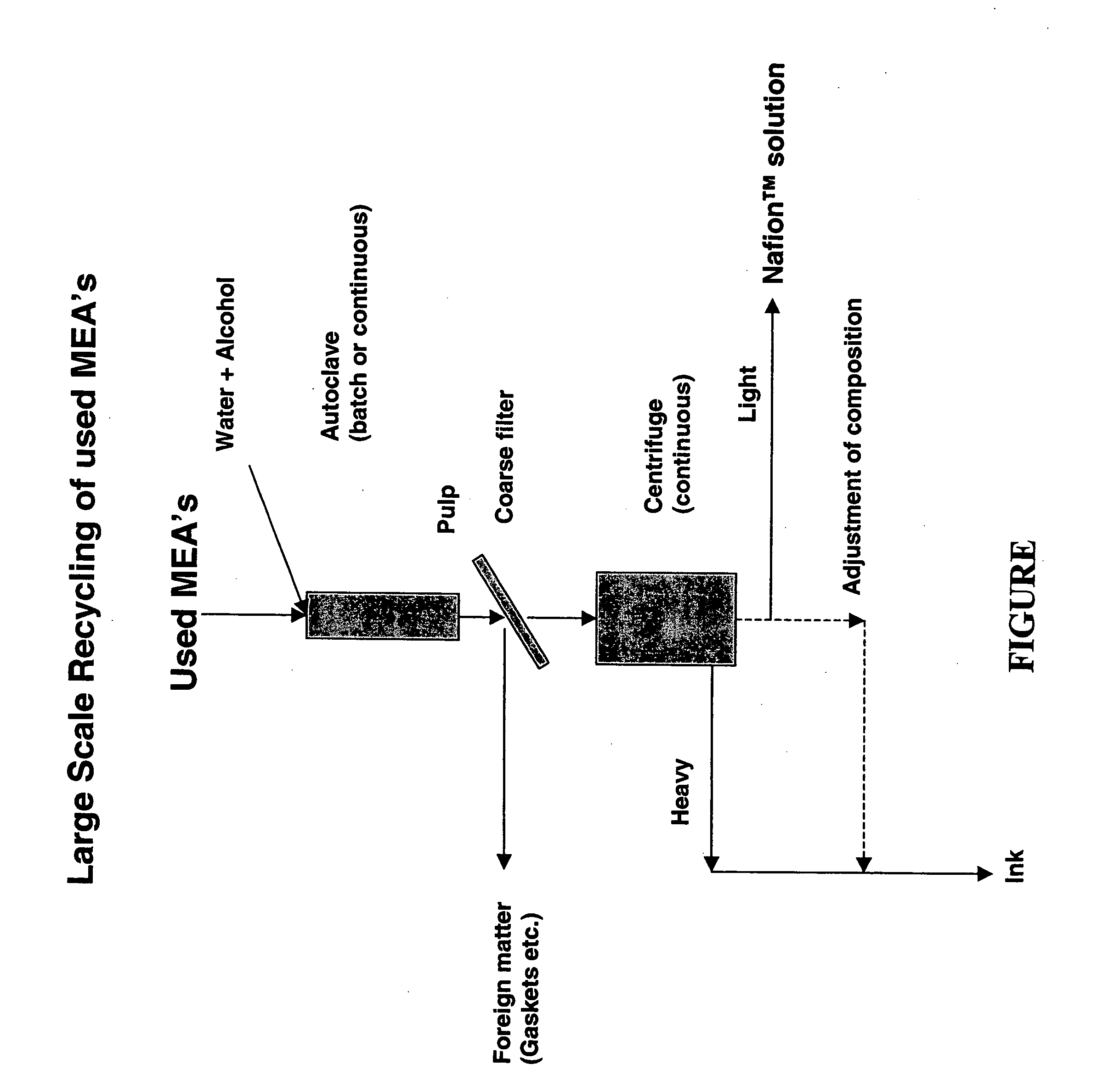Recycling of used perfluorosulfonic acid membranes
a perfluorosulfonic acid and membrane technology, applied in the field of recycling of used perfluorosulfonic acid membranes, can solve the problems of high energy consumption, contamination of high-temperature furnace equipment, and ill-suited pgm recovery from catalyst coated membranes (ccm), so as to increase the cost of fuel cells, increase the cost of platinum consumption, and the effect of long-term availability
- Summary
- Abstract
- Description
- Claims
- Application Information
AI Technical Summary
Benefits of technology
Problems solved by technology
Method used
Image
Examples
example 1
[0013] In the embodiment shown in the figure, a centrifuge is used for separation of pigment from the PFSA™ solution.
[0014] In this example of a preferred method, cut un-used catalyst coated membranes were autoclaved. The composition of the materials was
NAFION ®42.15 gmPt / C 9.55 gmKapton 1.3 gmTotal 53 gm
[0015] A standard solution making procedure was used that resulted in a low viscosity solution by autoclaving. The resulting mixture behaved as a typical catalyst / NAFION® solution ink as used in the manufacturing processes. During the processing, the stirrer and reactor head were covered with a black “ink”-like material. This material was collected into the total recovered batch from the autoclave with a water rinse. A total of 473 grams was recovered and separated by centrifugation.
[0016] In order to demonstrate the efficacy of the separation process, a Sorvall SS-3 Automatic Super-Speed centrifuge was used. The centrifuge has a controllable speed, and at its maximum rated spe...
example 2
[0021] A 70 gram sample of the recovered autoclave discharge was centrifuged and then rinsed further in a second centrifuge step. The resulting wet pigment cake weighed 3.3 gm and the estimated composition was:
NAFION ®unknown, target to be 0Pt / C1.4 gm (dry estimated)Solvent1.9 gm (estimated)Total3.3 gm
example 3
[0022] 23 grams of catalyst coated membranes (9 pieces of 300 cm 2) were autoclaved and centrifuged so that a catalyst powder was recovered and 500 ml of NAFION® solution was recovered. Of the 2.25 grams of catalyst powder that was recovered, 10% NAFION® remained, or 0.22 grams NAFION® of the 20.75 grams of NAFION® that was in the original samples. Thus the efficiency of recovery of the NAFION® is 98.9% of the original amount of NAFION®; recovered in a re-usable form as a 500 ml, 5 wt % clear NAFION® solution.
PUM
| Property | Measurement | Unit |
|---|---|---|
| temperature | aaaaa | aaaaa |
| pressure | aaaaa | aaaaa |
| pressure | aaaaa | aaaaa |
Abstract
Description
Claims
Application Information
 Login to View More
Login to View More - R&D
- Intellectual Property
- Life Sciences
- Materials
- Tech Scout
- Unparalleled Data Quality
- Higher Quality Content
- 60% Fewer Hallucinations
Browse by: Latest US Patents, China's latest patents, Technical Efficacy Thesaurus, Application Domain, Technology Topic, Popular Technical Reports.
© 2025 PatSnap. All rights reserved.Legal|Privacy policy|Modern Slavery Act Transparency Statement|Sitemap|About US| Contact US: help@patsnap.com

